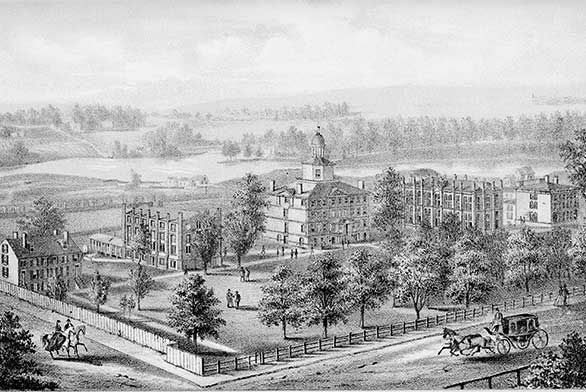St. John’s College Releases Report on College History and Slavery
College seeks community input on how to recognize history; Comment period now open
ANNAPOLIS, MD [November 1, 2024] — St. John’s College today released a historical report focused on the men for whom buildings on the college’s Annapolis campus are named and their association with the institution of slavery. In 2020, the St. John’s College History Task Force was created to research the college’s past in order to understand its relationship to indigenous and enslaved people, and to make recommendations to the Board of Visitors and Governors on how that history should be acknowledged. A discussion guide and comment form are now available for community members to provide feedback and ideas, which will be considered by the task force as they formulate these recommendations. Comments will be accepted until December 12, 2024.

“As the third-oldest college in the country, we knew that there would be parts of our history we wouldn’t—couldn’t—be proud of and that do not represent the college’s mission to provide an education for all,” says St. John’s College President Nora Demleitner. “This report gives us the opportunity to face our past head-on. I encourage feedback from all community members as we move forward to acknowledge our history and continue our focus as a place of belonging for students from all backgrounds.”
Founded in 1696 as King William’s School and chartered as St. John’s College in 1784, the institution has played an integral role in the history of the state of Maryland. Slavery was omnipresent throughout Maryland during the early years of the college, and by 1783, 46 percent of white households in the City of Annapolis owned slaves. Records do not detail the type of labor used for the construction of the college’s early buildings; however, five of the buildings documented in the report were constructed prior to the abolition of slavery in Maryland in 1864, including McDowell Hall (1789), Humphreys Hall (1837), Chase-Stone House (1857), Pinkney Hall (1858), and the Paca-Carroll House (1855). The architects and builders responsible for the buildings are known to have used construction crews that included enslaved African Americans. The report also concludes that, with few exceptions, the men who supported the college during its establishment and for the decades afterwards derived their wealth, directly or indirectly, from a legacy of slavery. In 1800, John McDowell, the first president of the College, owned a man in Anne Arundel County, who likely resided with him in present-day McDowell Hall. He did not free the man until 1807 when he moved to Pennsylvania, where the ownership of slaves was prohibited.
“My hope is that this report, along with future work of the task force, will encourage conversation about difficult topics—the hallmark of a St. John’s education,” says board member and College History Task Force Chair Adrian Trevisan (A84). “The report shows how slavery was a part of almost all aspects of the economy throughout the 13 colonies. Acknowledging that history must take that complexity into account—and I believe that Johnnies are well-equipped by their education to grapple with complexity and ambiguity.”
The report was made possible by grants from the State of Maryland’s Maryland Historical Trust and the France-Merrick Foundation. As part of the project, documentation in the Maryland Inventory of Historic Properties was updated for 16 campus buildings, two monuments, and the former site of the Liberty Tree. To read the updated Maryland Inventory of Historic Properties forms, visit Medusa, Maryland’s Cultural Resource Information System.
In addition to the report, the task force’s work has included the transcription of early college financial documents; a panel discussion on Francis Scott Key, the college’s most famous alumnus, featuring prominent Key historians and leadership from the Banneker-Douglass-Tubman Museum; and supporting instructional activities including a Graduate Institute preceptorial class on slavery in America. Visit sjc.edu/chtf for more information about the work of the St. John’s College History Task Force.
ABOUT ST. JOHN’S COLLEGE
St. John’s College is the most distinctive college in the country due to our interdisciplinary program, in which 200 of the most revolutionary great books from across 3,000 years of human thought are explored in student-driven, discussion-based classes. By probing world-changing ideas in literature, philosophy, mathematics, science, music, history, and more, students leave St. John’s with a foundation for success in such fields as law, government, research, STEM, media, and education. Located on two campuses in two historic state capitals—Annapolis, Maryland, and Santa Fe, New Mexico — St. John’s is the third-oldest college in the United States and has been hailed as the “most forward-thinking, future-proof college in America” by Quartz and as a “high-achieving angel hovering over the landscape of American higher education” by the Los Angeles Times. Learn more at sjc.edu.
# # #
MEDIA CONTACT: Sara Luell, Senior Director of Communications and Operations,

